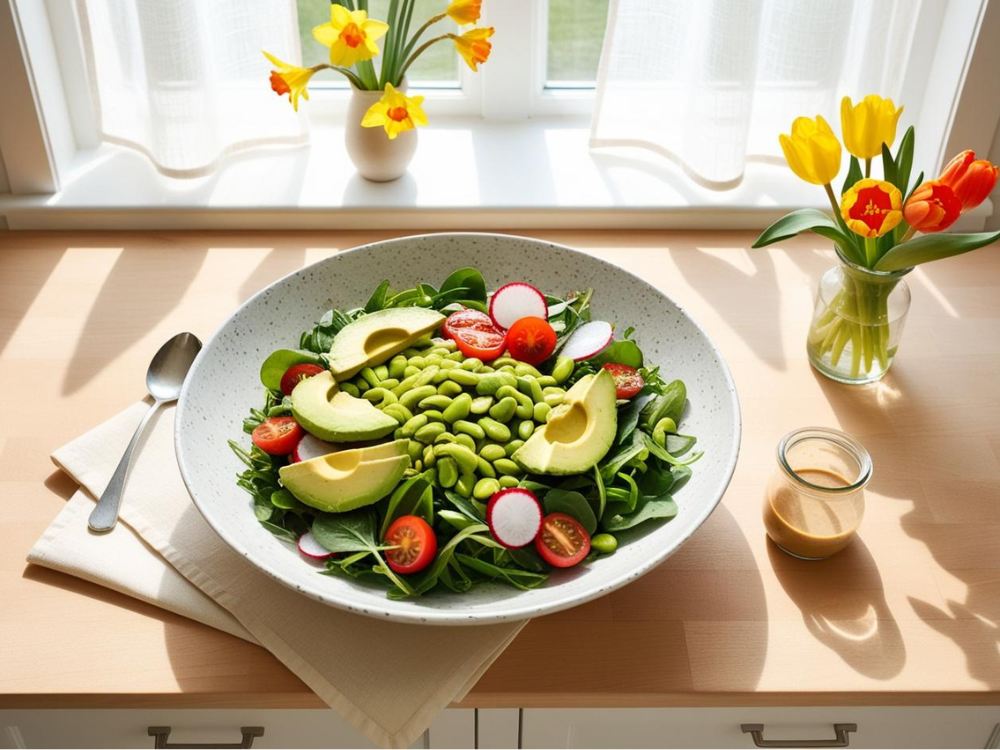Classic Ceviche
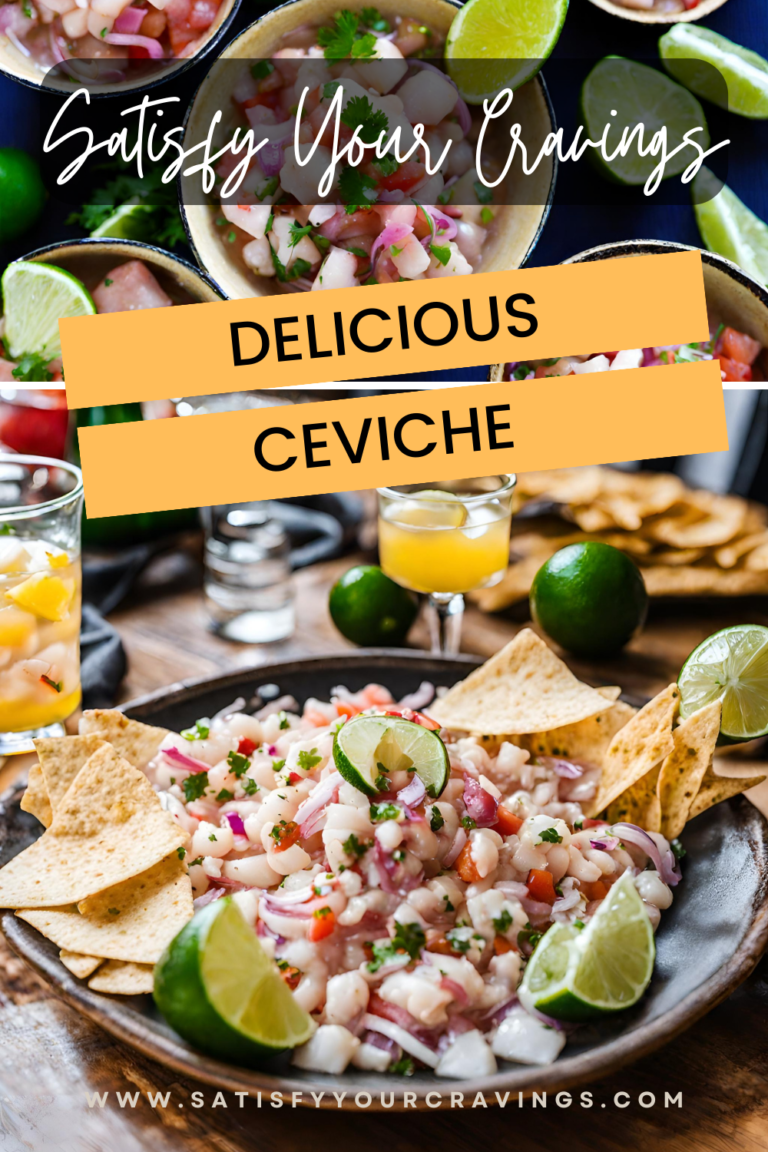
These partnerships help support our content and keep our recipes free for our amazing readers. We only recommend products and brands we personally use and trust in our own kitchen. Thank you for supporting us! 💛
Bright, Fresh, and Zesty: The Best Classic Ceviche Recipe
There’s something magical about a dish that’s light, fresh, and bursting with bold flavors—Classic Ceviche is exactly that. This Latin American favorite is all about simplicity, letting high-quality ingredients shine. Fresh white fish gets “cooked” in bright citrus juices, absorbing all that zesty goodness while staying incredibly tender. Toss in some crisp red onions, spicy jalapeños, juicy tomatoes, and fragrant cilantro, and you’ve got a dish that’s as beautiful as it is delicious. Whether you’re new to ceviche or a longtime fan, this recipe is sure to impress.
The best part? Classic Ceviche requires zero cooking! All you need is fresh fish, a handful of vibrant ingredients, and a little patience while the citrus does its work. Serve it with crunchy tortilla chips, spoon it over tostadas, or enjoy it straight from the bowl—no matter how you eat it, Classic Ceviche delivers an explosion of flavor in every bite. Perfect for warm weather, dinner parties, or just a light and refreshing meal, this dish is guaranteed to become a favorite.
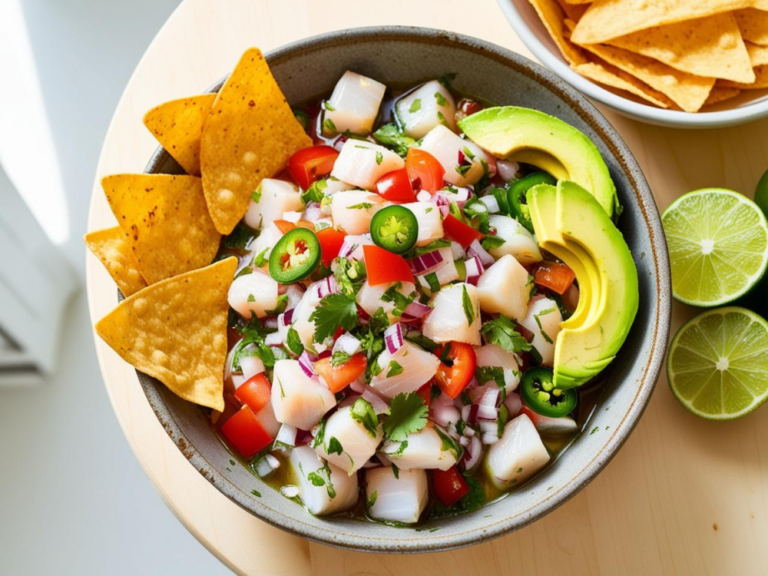
What is Classic Ceviche? A Taste of Freshness and Tradition
If you’ve ever taken a bite of Classic Ceviche, you know it’s more than just a dish—it’s an experience. This refreshing, citrusy seafood delicacy is a staple in many coastal regions, particularly in Latin America, where fresh fish is abundant and flavors are bold. But what makes Classic Ceviche so special? It’s the perfect blend of simplicity, freshness, and vibrant taste, all achieved without ever turning on the stove.
At its core, Classic Ceviche is raw white fish—typically sea bass, snapper, or halibut—cut into small pieces and marinated in citrus juice, usually a mix of lime and lemon. The magic happens when the citric acid from the juice begins to break down the proteins in the fish, giving it a firm, opaque texture similar to cooked seafood. This process, known as denaturation, is what makes ceviche so unique—it’s “cooked” without heat, preserving the fish’s delicate texture while infusing it with bright, zesty flavors.
But ceviche isn’t just about the fish. A perfect balance of finely chopped red onion, spicy jalapeño, juicy tomato, and fragrant cilantro brings depth and complexity to every bite. The combination of acidity, heat, and freshness creates a dish that’s light, yet incredibly satisfying. In many Latin American countries, ceviche is more than just food—it’s a way of life, often enjoyed with friends and family on warm days, paired with tortilla chips, tostadas, or even sweet plantains for a little contrast.
Though Classic Ceviche is commonly associated with Peru, where it’s considered a national dish, many countries have their own spin on it. In Mexico, for example, ceviche is often served with a touch of tomato juice for extra flavor, while Ecuadorians like to add a splash of orange juice for a hint of sweetness. No matter where it’s from, the essence of ceviche remains the same: fresh, high-quality ingredients, simple preparation, and a taste that instantly transports you to the coast.
If you’ve never made Classic Ceviche at home, now is the perfect time to try. With just a handful of ingredients and a little patience while the citrus works its magic, you’ll have a dish that’s both incredibly easy and deeply flavorful. So grab some fresh fish, squeeze those limes, and get ready to enjoy a timeless dish that has been loved for generations!
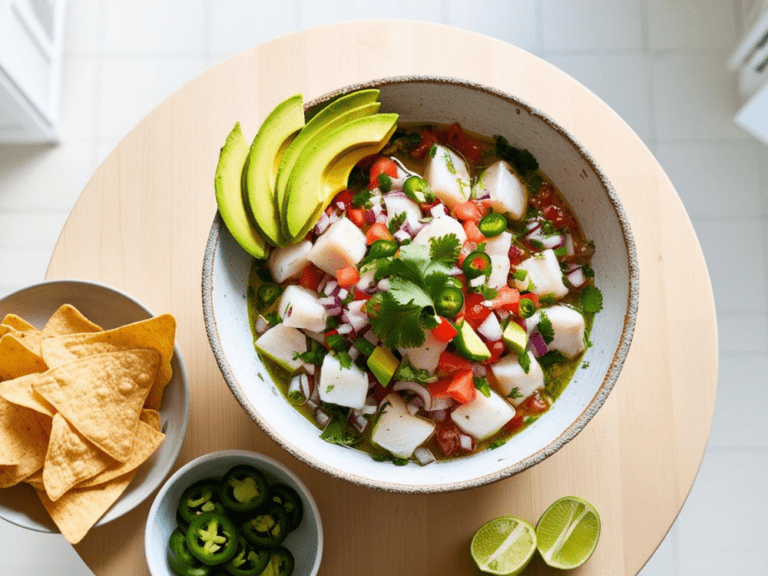
Breaking Down the Ingredients: What Makes Classic Ceviche So Flavorful?
At first glance, Classic Ceviche might seem like a simple dish—just fresh fish, citrus juice, and a few seasonings. But every ingredient plays a crucial role in creating the perfect balance of flavor and texture. Let’s take a deep dive into what makes Classic Ceviche so irresistible, and why each component matters.
1. The Fish – The Star of the Show
The foundation of Classic Ceviche is fresh, high-quality white fish. Since the fish is not cooked over heat, choosing the right type is essential. The best options are:
- Sea Bass – A firm, mild fish that holds up well in citrus juice.
- Snapper – Slightly sweet with a delicate texture.
- Halibut – Mild and meaty, great for absorbing flavors.
- Tilapia – A budget-friendly option that still works well.
Whatever fish you choose, freshness is key. Look for fish with clear eyes, firm flesh, and a clean, ocean-like smell. If fresh fish isn’t available, high-quality frozen fish can work—just make sure to thaw it properly in the refrigerator before using it.
2. Citrus Juice – The Cooking Agent
Unlike most seafood dishes that rely on heat, Classic Ceviche is “cooked” using the acidity of fresh citrus juice. Lime juice is the most common, but a mix of lime and lemon creates an even better balance of flavor. Some variations also include a touch of orange juice for a hint of sweetness.
The acidic properties of citrus juice break down the proteins in the fish, changing its texture and making it firm and opaque. This process, called denaturation, is what gives ceviche its signature “cooked” appearance and tender bite.
3. Red Onion – The Perfect Crunch
Thinly sliced or finely diced red onion adds a necessary bite to Classic Ceviche. The sharpness of the onion contrasts beautifully with the tartness of the citrus and the softness of the fish. For best results, soak the sliced onions in cold water for 10 minutes before adding them to the dish—this reduces their harshness while keeping their crisp texture.
4. Jalapeño or Serrano Pepper – A Spicy Kick
A little heat takes Classic Ceviche to the next level. Jalapeños provide a mild spice, while serrano peppers offer a more intense kick. If you love extra heat, you can even add a bit of habanero pepper for a fiery twist. To control the spice level:
- Remove the seeds for a milder flavor.
- Keep the seeds in for more heat.
- Use a mix of jalapeño and serrano for a balanced spice level.
5. Tomatoes – A Juicy Burst of Freshness
While tomatoes aren’t always included in Peruvian-style ceviche, they’re a common addition in Mexican-style Classic Ceviche. Their natural sweetness helps balance out the acidity and spice, adding extra texture and color to the dish. Choose ripe, firm tomatoes for the best results.
6. Cilantro – The Ultimate Flavor Booster
No Classic Ceviche is complete without fresh cilantro. Its bright, slightly citrusy taste complements the lime juice and enhances every bite. If you’re not a fan of cilantro, you can substitute it with fresh parsley or leave it out, but its fresh aroma really ties the dish together.
7. Salt & Pepper – The Final Touch
A pinch of salt is all it takes to bring out the flavors of the fish and citrus. Black pepper adds a subtle warmth, making the dish even more complex. For an extra depth of flavor, some people like to use sea salt or flaky salt instead of regular table salt.
8. Avocado – Creamy & Delicious (Optional but Highly Recommended!)
Avocado isn’t a traditional ingredient in Classic Ceviche, but adding it makes the dish even more satisfying. The creaminess of ripe avocado balances out the sharp citrus flavors and provides a contrast to the firm texture of the fish. If you’re adding avocado, gently fold it in just before serving to avoid it getting mushy.
9. Tortilla Chips or Tostadas – The Perfect Pairing
Classic Ceviche is delicious on its own, but serving it with something crispy takes it to another level. Tortilla chips or tostadas provide a crunchy contrast to the soft fish, making every bite more enjoyable. If you’re looking for a low-carb option, you can also serve it with cucumber slices or lettuce cups.
10. Lime Wedges – For Extra Zest
Even though the fish is already marinated in citrus, a fresh squeeze of lime before serving makes the flavors pop even more. Keeping lime wedges on the side allows guests to customize their ceviche to their taste.
Why the Right Ingredients Matter
Each ingredient in Classic Ceviche plays a role in creating the perfect balance of acidity, heat, texture, and freshness. Skimping on any one component can affect the overall taste, so it’s important to use high-quality ingredients.
When you combine fresh fish, bright citrus, crunchy onions, spicy peppers, and fragrant cilantro, you get a dish that’s simple yet incredibly flavorful. Whether you’re making it for a summer gathering or just a light meal, Classic Ceviche is proof that the best recipes don’t need to be complicated—they just need the right ingredients!
Try some of our other recipes!
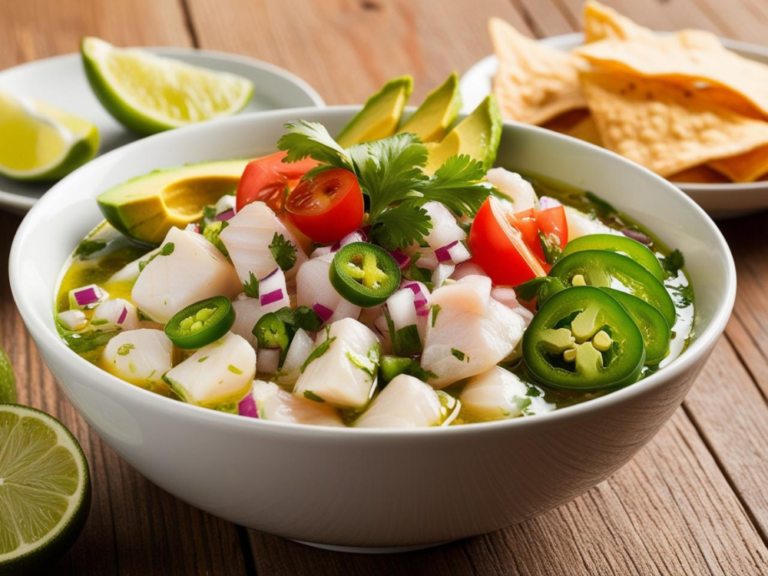
How to Choose the Best Fish for Classic Ceviche
When making Classic Ceviche, the fish you choose can make or break the dish. Since this recipe relies on raw fish being “cooked” by citrus juice rather than heat, quality and freshness are the most important factors. Choosing the right type of fish ensures that your ceviche has the perfect texture, flavor, and food safety. Here’s everything you need to know about selecting the best fish for Classic Ceviche.
1. What Type of Fish Works Best for Classic Ceviche?
The best fish for Classic Ceviche should be mild, firm, and fresh. You want a fish that won’t fall apart in the marinade and will absorb the citrus flavor beautifully. Here are the top choices:
Best Fish for Classic Ceviche
✅ Sea Bass – A classic choice with a firm texture and slightly sweet flavor.
✅ Snapper – Mild and slightly flaky but still holds up well in the marinade.
✅ Halibut – A meaty fish that remains firm and absorbs flavors beautifully.
✅ Mahi-Mahi – A bit more delicate, but works well with fresh citrus and spice.
✅ Tilapia – An affordable option that still produces great results.
All of these options have low oil content, making them ideal for ceviche. Oily fish, such as salmon or mackerel, are too rich and overpower the delicate acidity of the citrus juice.
2. Fresh vs. Frozen: Can You Use Frozen Fish?
Fresh fish is always the best choice for Classic Ceviche, but if you can’t get your hands on high-quality fresh fish, frozen can work too—as long as it’s sushi-grade.
Here’s why:
- Most fish sold at grocery stores is frozen shortly after being caught. This process kills parasites and preserves freshness.
- Look for “sushi-grade” or “sashimi-grade” fish. This means it has been handled and frozen in a way that makes it safe for raw consumption.
- Thaw it properly. If using frozen fish, let it thaw slowly in the refrigerator (not at room temperature) to maintain texture and freshness.
If you’re unsure whether a fish is safe for raw consumption, ask your fishmonger or opt for a frozen, sushi-grade variety.
3. How to Tell If Your Fish Is Fresh
Since Classic Ceviche relies on raw fish, freshness is non-negotiable. Here are the key signs of fresh, high-quality fish:
✔️ Clear, bright eyes – If buying whole fish, the eyes should be clear and not cloudy.
✔️ Firm flesh – Press on the fish with your finger—it should bounce back instead of staying indented.
✔️ Mild, ocean-like smell – Fresh fish should never smell overly “fishy” or ammonia-like.
✔️ Moist, shiny appearance – Dry or dull-looking fish is a sign it’s past its prime.
✔️ No slimy texture – If the fish feels slimy or sticky, it’s not fresh.
If you’re buying pre-cut fish fillets, make sure they’re firm, moist, and have a translucent quality.
4. Where to Buy the Best Fish for Classic Ceviche
Getting your fish from a reliable source is just as important as picking the right type. Here are the best places to find high-quality fish:
🛒 Fish Markets – Your local seafood market is often the best place to find fresh fish. Ask when they get their shipments and choose the freshest option available.
🛒 Grocery Stores with a High Turnover – If your grocery store has a busy seafood section, chances are the fish is fresher because it’s sold quickly.
🛒 Asian Markets – Many Asian grocery stores sell sushi-grade fish at reasonable prices, making them a great option.
🛒 Online Seafood Suppliers – Some companies ship sushi-grade fish directly to your door. Look for reputable sources with good reviews.
5. How to Properly Prepare Fish for Ceviche
Once you’ve chosen your fish, it’s time to prepare it for Classic Ceviche. Here’s how to do it right:
🔪 1. Keep It Cold – Always store fish in the refrigerator until you’re ready to use it. If preparing it later, keep it over ice to maintain freshness.
🔪 2. Use a Sharp Knife – A sharp knife ensures clean cuts and prevents the fish from becoming mushy.
🔪 3. Remove Any Skin or Bones – If your fish has skin, remove it before cutting. Run your fingers along the fillet to check for small bones and remove them with tweezers.
🔪 4. Cut It into Uniform Pieces – For the best texture, cut the fish into small, bite-sized cubes (about ½-inch). This helps it “cook” evenly in the citrus juice.
6. Food Safety Tips for Raw Fish
Because Classic Ceviche is made with raw fish, food safety is critical. Follow these steps to ensure your dish is safe to eat:
⚠️ Buy from a trusted source – Always buy fish that is labeled sushi-grade or safe for raw consumption.
⚠️ Keep everything clean – Use a separate cutting board for raw fish and wash hands and utensils thoroughly.
⚠️ Marinate in the fridge – Never leave fish sitting at room temperature. Always let it marinate in the refrigerator.
⚠️ Consume within 24 hours – Ceviche is best enjoyed fresh. While it can be stored for up to a day, the texture starts to change.
⚠️ Be mindful of who eats it – Pregnant women, young children, and individuals with compromised immune systems should avoid raw fish.
Final Thoughts: Choosing the Best Fish for Classic Ceviche
Picking the right fish is the most important step in making Classic Ceviche. Whether you choose sea bass, snapper, or another mild white fish, freshness and quality should be your top priorities. If fresh fish isn’t available, frozen sushi-grade fish is a safe alternative.
Once you’ve got the perfect fish, the rest of the dish comes together effortlessly—just a little citrus, some fresh vegetables, and a few seasonings. When done right, Classic Ceviche is a dish that highlights the natural flavors of the ocean in the freshest way possible.
Now that you know how to choose the best fish, it’s time to get chopping and start making your own Classic Ceviche at home! 🐟🍋

Common Mistakes to Avoid When Making Classic Ceviche
Making Classic Ceviche seems simple—just fresh fish, citrus juice, and a few seasonings, right? While it’s an easy dish to prepare, there are several common mistakes that can ruin the texture, flavor, or even the safety of your ceviche. To ensure you get that perfect balance of freshness, acidity, and texture every time, here’s what you need to avoid.
1. Over-Marinating the Fish
One of the biggest mistakes people make when preparing Classic Ceviche is leaving the fish in citrus juice for too long. While the acid “cooks” the fish, it doesn’t stop the process once the fish turns opaque. The longer it sits, the firmer and drier it becomes.

- Thinly cut fish (¼-inch pieces): 15-20 minutes
- Medium-sized cubes (½-inch pieces): 30-45 minutes
- Larger pieces (¾-inch or more): Up to 1 hour
If you leave the fish marinating for hours, it can become rubbery, tough, and chalky. If you want to prep ceviche in advance, you can chop the fish and store it separately in the fridge, adding the citrus juice just before serving.
2. Using the Wrong Type of Fish
Not all fish are suitable for Classic Ceviche. Choosing the wrong fish can result in a mushy, overly oily, or overpowering dish.

- Oily fish (salmon, mackerel, sardines) – These have a strong flavor and don’t pair well with citrus.
- Delicate fish (flounder, sole, cod) – These can fall apart in the marinade.
- Farm-raised fish with high water content – They often lack the firm texture needed for ceviche.

- Sea bass
- Snapper
- Halibut
- Mahi-mahi
- Tilapia (budget-friendly)
Always choose the freshest fish possible or opt for sushi-grade frozen fish if fresh isn’t available.
3. Not Using Fresh Citrus Juice
Bottled lime or lemon juice might seem convenient, but it’s a huge mistake in Classic Ceviche. Pre-packaged citrus juice lacks the natural brightness and can have a bitter or artificial aftertaste.

4. Overpowering the Dish with Too Much Acid
While citrus juice is essential for curing the fish, too much of it can make the ceviche overly sour and mask the other flavors.

- Use just enough juice to coat and submerge the fish. It should be enough to “cook” it but not drown it.
- Drain excess juice after marinating if you prefer a lighter citrus flavor.
A ceviche that’s too acidic can make it unpleasantly sharp, throwing off the balance of the dish.
5. Not Balancing the Flavors
Classic Ceviche is all about balance—tangy, spicy, fresh, and slightly salty. A common mistake is forgetting to adjust the flavors after the fish has marinated.

- If it’s too acidic: Add a drizzle of olive oil, diced avocado, or a small splash of coconut milk to soften the tartness.
- If it’s too bland: Add a pinch of salt and fresh cilantro to enhance the flavors.
- If it’s too spicy: Reduce the jalapeño or serrano peppers and add more tomato for sweetness.
Taste as you go and adjust before serving to get that perfect balance.
6. Chopping Ingredients Too Large or Too Small
The texture of Classic Ceviche is just as important as the flavor. Cutting ingredients the wrong size can ruin the experience.

- Fish that is too finely chopped – It can become mushy and lose its structure.
- Vegetables that are too large – They can overpower the delicate fish and create an uneven bite.

- Fish cubes: ½-inch pieces (bite-sized but still firm).
- Red onion: Thin slices or finely diced.
- Jalapeños: Minced for even spice distribution.
- Tomatoes: Small, uniform dice to blend seamlessly into the dish.
Consistency in chopping makes the ceviche more enjoyable to eat!
7. Not Using Enough Salt
Some people forget that Classic Ceviche needs salt to bring out the flavors. Without it, the fish and citrus can taste flat.

- Add sea salt or kosher salt gradually and taste as you go.
- The salt enhances the natural flavors and balances the acidity.
If your ceviche tastes “off,” it might just need a pinch more salt!
8. Letting Ceviche Sit for Too Long
Freshness is key! Classic Ceviche is meant to be eaten as soon as it’s ready—ideally within an hour of preparation.

- Letting it sit overnight in citrus (it will over-marinate and lose texture).
- Storing leftovers for more than 24 hours (the fish will break down and become mushy).

- If you must store it, drain the excess liquid and refrigerate in an airtight container.
- Eat within 24 hours for the best taste and texture.
But honestly? Classic Ceviche is best enjoyed fresh!
9. Not Pairing It with the Right Sides
A lot of people overlook what to serve with Classic Ceviche, but the right pairing makes a huge difference.

- Tortilla chips or tostadas – For the perfect crunch.
- Cucumber slices – A refreshing, low-carb alternative.
- Avocado slices – Adds creaminess to balance acidity.
- Sweet plantains or yuca chips – A delicious contrast to the tartness.
Pairing it with the right sides enhances the overall experience!
10. Forgetting to Garnish Before Serving
A little garnish goes a long way in making Classic Ceviche look as good as it tastes!

- Fresh cilantro
- Extra lime wedges
- Avocado slices
- A drizzle of olive oil
Small finishing touches make a big difference in presentation and flavor.
Making Classic Ceviche is easy, but avoiding these common mistakes ensures your dish turns out flavorful, fresh, and perfectly balanced every time. By using fresh fish, the right amount of citrus, and balancing textures and flavors, you’ll be on your way to making restaurant-quality ceviche at home.
Now that you know what NOT to do, it’s time to get chopping and make the best Classic Ceviche of your life!
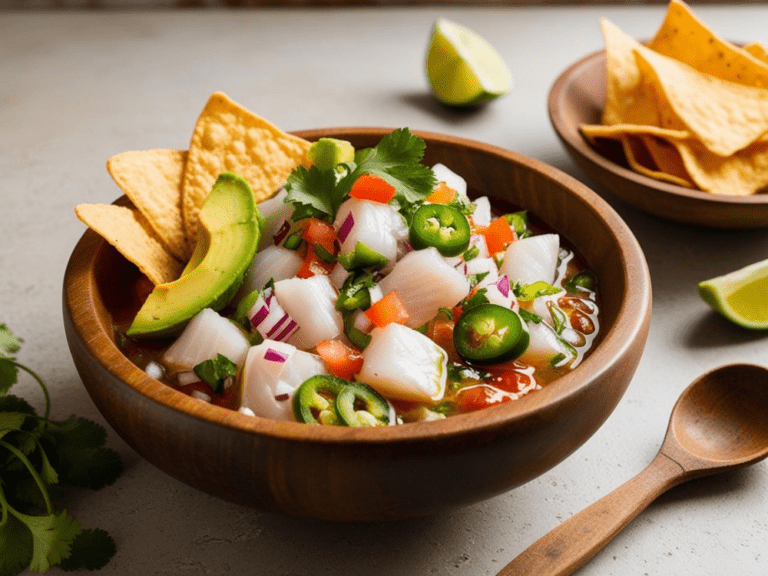
The Best Pairings for Classic Ceviche: What to Serve with This Refreshing Dish
Classic Ceviche is one of those dishes that’s so light, fresh, and flavorful that it can stand on its own. But let’s be honest—pairing it with the right sides and drinks takes it to the next level. The key to choosing the perfect accompaniments is to complement the zesty citrus flavors, the tender fish, and the slight heat from jalapeños or serranos.
Whether you want something crispy, creamy, or refreshing to balance the acidity, there are plenty of delicious ways to serve Classic Ceviche. Here are some of the best pairings to turn this dish into an unforgettable meal.
1. The Perfect Crunch: Chips, Tostadas, and Crackers
There’s something incredibly satisfying about scooping up a bite of Classic Ceviche with a crunchy base. The crisp texture balances the tender fish and adds an extra layer of flavor.
✅ Best Crunchy Pairings:
- Tortilla Chips – A classic and easy pairing that complements the flavors perfectly. Opt for lightly salted chips to avoid overpowering the ceviche.
- Tostadas – Flat, crispy corn tortillas that make a perfect base for piling on ceviche.
- Saltine Crackers – A traditional pairing in many coastal areas; their mild saltiness enhances the citrus flavors.
- Plantain Chips – A fantastic option if you want a slightly sweet contrast to the acidity of the ceviche.
If you’re feeling adventurous, you can even make homemade tortilla chips by baking or frying corn tortillas until golden and crispy!
2. Creamy Additions: Avocado, Guacamole, and Coconut Milk
Since Classic Ceviche is naturally acidic, pairing it with something creamy can help balance the tartness and create a more satisfying bite.
✅ Best Creamy Pairings:
- Sliced Avocado – Adding slices of creamy avocado directly to your ceviche or serving them on the side mellows out the citrus and adds richness.
- Guacamole – A great dip to serve alongside ceviche if you’re eating it with chips.
- Coconut Milk – Some variations of ceviche use a splash of coconut milk to soften the acidity and add a tropical touch.
Pro tip: If you love avocado but don’t want it to overpower the dish, try dicing it and gently folding it into the ceviche just before serving!
3. Classic Latin American Sides for Ceviche
If you want to enjoy Classic Ceviche the traditional way, pair it with some of these authentic Latin American sides that bring out its best flavors.
✅ Best Traditional Sides:
- Sweet Potatoes (Camote) – In Peru, ceviche is often served with slices of boiled sweet potato. The sweetness contrasts beautifully with the tart lime juice.
- Corn (Choclo or Canchita) – Another Peruvian favorite, this large-kernel corn adds a nice chewy texture that pairs well with ceviche.
- Yuca Fries – Crispy on the outside and fluffy inside, yuca fries add heartiness to the meal.
- Rice – A simple side of white rice can soak up the citrus juices and balance out the acidity.
If you want to try an authentic ceviche experience, adding sweet potato or corn to your plate is a must!
4. Fresh Salads and Light Vegetables
Since Classic Ceviche is already packed with fresh ingredients, pairing it with a crisp salad or light veggies enhances the meal without overpowering it.
✅ Best Salads & Veggies:
- Cucumber Slices – A refreshing, hydrating side that complements the citrusy flavors.
- Shredded Cabbage – Adds crunch and a slightly sweet taste that balances the acidity.
- Tomato and Avocado Salad – A simple salad with lime dressing pairs beautifully with ceviche.
- Grilled Vegetables – Lightly charred zucchini, bell peppers, or asparagus add depth to the meal.
Pairing ceviche with light, crunchy vegetables keeps the meal fresh and healthy while adding variety in texture.
5. Drinks That Pair Well with Classic Ceviche
A great drink can enhance the flavors of Classic Ceviche, especially when it complements the acidity and freshness of the dish. Whether you prefer something alcoholic or non-alcoholic, here are some top choices:
🍹 Best Alcoholic Pairings:
- Crisp White Wine – Sauvignon Blanc, Albariño, or Pinot Grigio are all great choices because they’re light, citrusy, and refreshing.
- Sparkling Wine – The bubbles cleanse the palate and enhance the bright flavors of ceviche.
- Light Beers – Mexican lagers like Corona, Modelo, or Pacifico are classic pairings with ceviche.
- Michelada – A spicy, tangy beer cocktail made with lime juice, hot sauce, and beer—it’s like a Bloody Mary but better with seafood.
- Margaritas – A classic lime margarita complements the citrus flavors in the ceviche.
🥤 Best Non-Alcoholic Pairings:
- Agua Fresca – A refreshing fruit-based drink (like watermelon, pineapple, or tamarind agua fresca) balances out the acidity.
- Coconut Water – Light, hydrating, and slightly sweet—perfect if your ceviche has a tropical twist.
- Sparkling Water with Lime – A simple and refreshing way to cleanse the palate between bites.
Pro Tip: If your ceviche is on the spicy side, go for a slightly sweet drink to help tame the heat!
6. Unique and Unexpected Pairings
If you want to get creative, here are a few unique ways to serve Classic Ceviche that will surprise and impress your guests:
✅ Unexpected but Delicious Pairings:
- Ceviche Tacos – Spoon ceviche into soft corn tortillas and top with avocado or slaw for a fresh twist on tacos.
- Ceviche-Stuffed Avocados – Instead of serving avocado on the side, hollow out an avocado half and fill it with ceviche for a beautiful presentation.
- Ceviche Lettuce Wraps – A low-carb option where ceviche is served inside crisp romaine or butter lettuce leaves.
- Ceviche Nachos – Top crispy tortilla chips with a spoonful of ceviche and a drizzle of spicy aioli.
These unique ideas elevate ceviche beyond just a simple appetizer and turn it into a show-stopping dish!
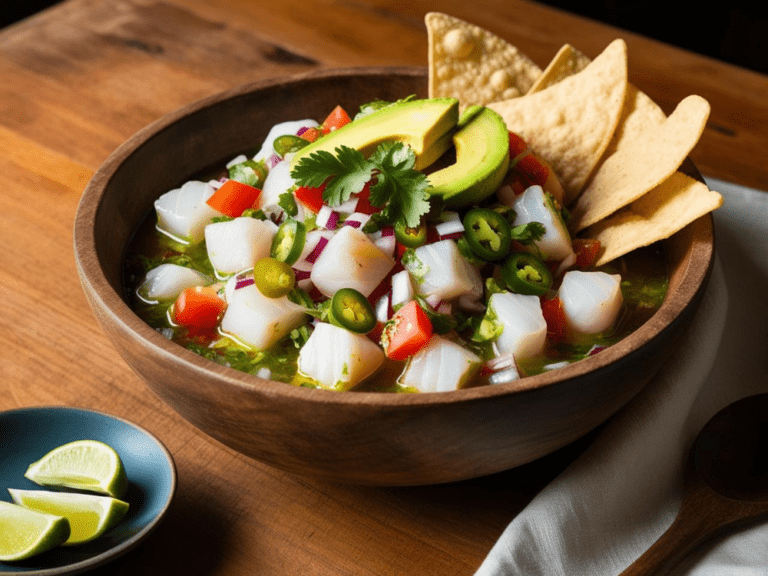
Frequently Asked Questions About Classic Ceviche
Classic Ceviche is a dish that’s loved for its fresh, bright flavors and simple preparation. But if you’ve never made it before, you might have some questions about how it works, how to ensure it’s safe to eat, and how to customize it to your taste. Whether you’re wondering about the best fish to use, how long ceviche lasts, or what to do if you’re short on lime juice, this FAQ section has you covered.
1. What is Classic Ceviche?
Classic Ceviche is a dish made with raw white fish that is cut into small pieces and marinated in fresh lime or lemon juice. The acidity in the citrus juice “cooks” the fish by breaking down its proteins, giving it a firm, opaque texture similar to cooked fish. It’s typically mixed with ingredients like red onion, jalapeños, tomatoes, cilantro, and salt for a refreshing, flavorful dish.
2. How Long Should I Marinate the Fish?
The ideal marination time depends on the size of the fish pieces:
- Thin slices (¼-inch thick) – 15-20 minutes
- Medium cubes (½-inch thick) – 30-45 minutes
- Larger pieces (¾-inch or more) – Up to 1 hour
The fish should turn opaque and firm once it’s properly “cooked” in the citrus juice. Over-marinating (more than 2 hours) can make the fish rubbery and overly acidic.
3. Can I Use Frozen Fish for Ceviche?
Yes! In fact, frozen fish is often safer for Classic Ceviche because freezing kills potential parasites. However, only use high-quality, sushi-grade frozen fish. Be sure to:
- Thaw the fish slowly in the refrigerator (not at room temperature).
- Pat it dry with paper towels before cutting.
Avoid fish that has been frozen for too long, as it may develop a mushy texture when thawed.
4. How Do I Know If My Fish Is Fresh Enough for Ceviche?
Fresh fish is crucial for making Classic Ceviche. Look for these signs of freshness:
✔️ Clear, bright eyes (if buying a whole fish)
✔️ Firm flesh that bounces back when pressed
✔️ Mild, ocean-like smell (not overly “fishy”)
✔️ No slimy texture or discoloration
If in doubt, ask your fishmonger if the fish is safe for raw consumption or opt for sushi-grade fish.
5. Can I Make Ceviche Ahead of Time?
It’s best to prepare Classic Ceviche fresh, but if you need to make it ahead:
- Chop all the ingredients in advance and store them separately.
- Add citrus juice to the fish about 30-45 minutes before serving.
- Avoid adding avocado until the last minute to prevent browning.
Leftover ceviche can be refrigerated for up to 24 hours, but the texture changes as the fish continues to marinate.
6. How Long Does Ceviche Last in the Fridge?
Classic Ceviche is best enjoyed within a few hours of making it. However, if you have leftovers:
- Store in an airtight container in the refrigerator.
- Eat within 24 hours for the best taste and texture.
- Do not freeze ceviche, as the texture will become mushy when thawed.
After 24 hours, the fish may become too firm or mushy due to over-marination.
7. What If I Don’t Have Enough Lime Juice?
If you’re short on lime juice, you can substitute with:
✔️ Fresh lemon juice (for a slightly different acidity)
✔️ A small amount of orange juice (for a sweeter balance)
✔️ A splash of vinegar (to increase acidity)
Always use fresh citrus juice—bottled juice lacks the brightness and can have a bitter aftertaste.
8. Can I Use Other Types of Seafood in Ceviche?
Absolutely! While white fish is the traditional choice for Classic Ceviche, you can try:
🐟 Shrimp – Pre-cook in boiling water for 1-2 minutes if you prefer.
🐙 Octopus – Often pre-cooked before marinating in citrus.
🦑 Squid (Calamari) – Lightly blanched before adding to the mix.
🦐 Scallops – Naturally sweet and tender, perfect for ceviche.
🦀 Crab or Lobster – Works well for a luxurious version.
Different seafood has different textures, so adjust marination times accordingly.
9. My Ceviche is Too Sour – How Can I Fix It?
If your Classic Ceviche tastes too tart, try balancing the acidity with:
✔️ A drizzle of olive oil – Adds richness and smooths out the acidity.
✔️ A pinch of sugar or honey – Helps tone down excessive tartness.
✔️ Diced avocado – Its creaminess balances the sharp citrus.
✔️ A splash of coconut milk – A trick used in some Latin American variations.
A little salt and black pepper can also help balance the flavors!
10. Can I Make Spicy Ceviche?
Yes! To add more heat to your Classic Ceviche, try:
🔥 Jalapeños or serrano peppers (classic choice)
🔥 Habanero peppers (for extra heat)
🔥 A dash of hot sauce (like Tabasco or Valentina)
🔥 A pinch of cayenne or chili flakes
To control the spice level, remove the pepper seeds for milder heat or leave them in for a fiery kick.
11. What’s the Best Way to Serve Ceviche?
Classic Ceviche is traditionally served with:
🌮 Tostadas – Crispy corn tortillas make the perfect base.
🥑 Avocado slices – Adds creaminess and richness.
🥭 Mango or pineapple – Balances acidity with natural sweetness.
🌽 Corn or sweet potatoes – A Peruvian-style addition.
🥒 Cucumber slices – A refreshing, low-carb option.
Don’t forget lime wedges on the side so guests can adjust the acidity to their liking!
12. Is Ceviche Safe to Eat If I’m Pregnant?
Since Classic Ceviche contains raw fish, pregnant women should avoid it due to the risk of bacteria and parasites. If you’re pregnant and craving ceviche, you can:
✔️ Use fully cooked shrimp instead of raw fish.
✔️ Lightly poach the fish before marinating it.
Always consult with your doctor before consuming raw seafood during pregnancy.
These partnerships help support our content and keep our recipes free for our amazing readers. We only recommend products and brands we personally use and trust in our own kitchen. Thank you for supporting us! 💛
🛍️ Shop the Recipe: Classic Ceviche Essentials
Bring the flavors of the coast to your kitchen with fresh, bright, and citrusy Classic Ceviche! These kitchen tools and clean ingredient picks make it easy to prepare this no-cook seafood dish like a pro. 🌊🍤🍋
🍽️ Kitchen Tools You’ll Love
Citrus Juicer or Reamer – Make juicing all those limes and lemons effortless.
👉 Shop citrus juicers on AmazonGlass Mixing Bowls (Non-Reactive) – Essential for marinating seafood safely without affecting flavor.
👉 Find glass mixing bowls hereChef’s Knife and Cutting Board – Precision slicing for shrimp, onions, peppers, and herbs.
👉 Browse knife and board setsSlotted Spoon or Strainer – For draining excess citrus juice before serving.
👉 Check out slotted spoonsServing Bowls or Glasses – Elevate presentation by serving your ceviche in small glass cups or bowls.
👉 Shop serving sets
🧂 Clean Ingredients for the Perfect Ceviche
Raw Shrimp or White Fish (Sushi-Grade Preferred) – The star of the show, make sure it’s super fresh!
👉 Shop seafood optionsFresh Limes and Lemons – The essential citrus base that “cooks” the seafood.
👉 Browse fresh citrusRed Onion – Adds crunch and a sharp, vibrant bite.
👉 Find red onions hereRoma Tomatoes or Cherry Tomatoes – Brings a juicy, colorful contrast to the mix.
👉 Grab fresh tomatoesCilantro (Fresh or Freeze-Dried) – Bright, fresh herbs that elevate the flavor.
👉 Shop cilantro optionsJalapeño or Serrano Peppers – Adds a touch of heat to balance the citrus.
👉 Buy fresh jalapeñosAvocado (Optional) – Creamy texture and healthy fats to balance the acidity.
👉 Find fresh avocadoSea Salt & Black Pepper – Simple seasoning to bring it all together.
👉 Shop salt & pepper sets
💡 Pro Tip: Always serve your ceviche chilled and enjoy it with tortilla chips, tostadas, or cucumber slices for the ultimate refreshing bite 🥑🍋
Thank you for supporting Satisfy Your Cravings by shopping through our affiliate links — every purchase helps us continue bringing fresh, healthy, and flavorful recipes right to your kitchen ❤️
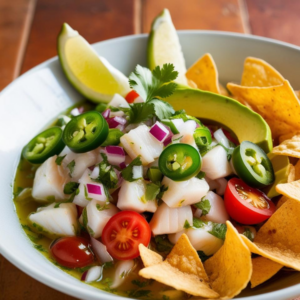
Classic Ceviche
Equipment
- Sharp Chef’s Knife: For cutting the fish into even, bite-sized pieces without crushing the texture. A sharp blade prevents the fish from becoming mushy.
- Cutting Board: Use a separate board for fish to maintain food safety. A non-porous plastic or glass board is best for seafood preparation.
- Citrus Juicer or Reamer: Extracts fresh lime and lemon juice efficiently, ensuring the best flavor without bottled substitutes.
- Mixing Bowl (Glass or Ceramic): A non-reactive bowl (glass or ceramic) prevents any metallic taste from interfering with the citrus marination. Avoid metal bowls as they can alter the flavor.
- Measuring Cups & Spoons: Helps maintain the right balance of citrus juice, seasoning, and additional ingredients.
- Spoon or Spatula: Gently mixes the ceviche to ensure even coating of citrus without breaking the delicate fish pieces.
- Plastic Wrap or Lid: Covers the bowl while the fish marinates in the fridge, keeping it fresh and ensuring food safety.
- Serving Dish: A shallow bowl or platter works best for presentation, making it easy to scoop and serve.
- Tongs or Slotted Spoon (Optional): Useful for draining excess citrus juice before serving, depending on your preferred ceviche texture.
Ingredients
- 1 Lb Fresh, firm white fish (such as sea bass, tilapia, or snapper), finely diced
- 10 Limes, freshly squeezed
- 1 Medium red onion, thinly sliced
- 2 Serrano chilies, finely chopped (adjust based on your heat preference)
- 1 Cup Fresh cilantro, chopped
- Salt, to taste
- Black pepper, freshly ground, to taste
- Optional: 1 ripe avocado, diced for garnish
- Optional: 1 sweet potato, boiled and sliced for serving
Instructions
- Prepare the Fish: In a glass or ceramic bowl, combine the diced fish with salt and black pepper. Cover with lime juice. The juice should completely submerge the fish—this is key to "cooking" it properly.
- Marinating Magic: Let the fish marinate in the refrigerator for about 15-30 minutes. You’re looking for the fish to become opaque and slightly firm to the touch.
- Add Crunch and Flavor: Drain some of the lime juice (keep a bit to maintain moisture), and add the sliced red onion and chopped serrano chilies to the fish. Toss gently to combine.
- Final Touches: Mix in the fresh cilantro, and adjust salt and pepper to taste. If using, add the diced avocado and gently fold it in to avoid mashing it.
Notes
- Chop the fish and store it separately: Keep it in an airtight container in the fridge for up to 24 hours before marinating.
- Prep the vegetables: Dice the onions, jalapeños, tomatoes, and cilantro ahead of time and store them separately in airtight containers.
- Juice the citrus: Fresh lime and lemon juice can be squeezed and refrigerated for up to 24 hours in a sealed jar.
- Assemble just before serving: Combine everything 30-45 minutes before eating to allow the fish to marinate properly without overcooking.
- Refrigerate immediately: Store leftover ceviche in an airtight container and keep it in the fridge for up to 24 hours.
- Drain excess citrus juice: To prevent the fish from becoming too firm or mushy, you can remove some of the marinade before storing.
- Avoid freezing: Freezing ceviche is not recommended as the texture of the fish will become unpleasantly soft when thawed.
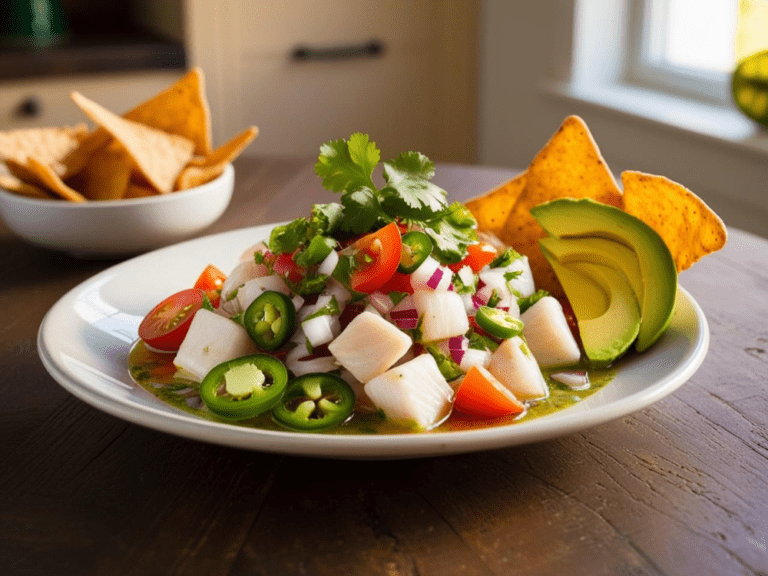
The Joy of Classic Ceviche
At the heart of Classic Ceviche is something truly special—fresh ingredients, simple preparation, and bold, vibrant flavors that bring people together. Whether you’re making it for a summer gathering, a cozy meal at home, or just because you’re craving something light and refreshing, ceviche is one of those dishes that always delivers.
What makes Classic Ceviche so magical isn’t just the bright citrus, the tender fish, or the perfect balance of spice and crunch—it’s the experience of making and sharing it. It’s a dish that invites creativity, encourages connection, and reminds us that some of the best meals in life are the simplest ones.
So the next time you whip up a batch of Classic Ceviche, take a moment to appreciate the fresh ingredients, the perfect bite, and the joy of sharing something delicious with others. Whether you’re pairing it with crispy tostadas, a cold drink, or just eating it straight from the bowl, one thing is certain—every bite is a taste of sunshine, the ocean, and pure happiness.
If you try this recipe, let me know how it turns out! I’d love to hear your thoughts, see your creations, and connect with fellow ceviche lovers. Happy cooking, and enjoy every bite of your homemade Classic Ceviche!
Join Now!
Love this recipe? Don’t miss out on even more delicious, healthy, and easy-to-make recipes like this Classic Ceviche! By joining our email community, you’ll gain access to exclusive content, bonus recipes, and tips to make clean eating a breeze.
Enter your email & click below to subscribe and start receiving tasty inspiration right away. It only takes a minute to join our growing community of food lovers dedicated to making healthy eating delicious and fun.
These partnerships help support our content and keep our recipes free for our amazing readers. We only recommend products and brands we personally use and trust in our own kitchen. Thank you for supporting us! 💛

